Braised pork belly (红烧肉/hong shao rou/red cooked pork) is a well-known pork dishes prepared with a combination of ginger, garlic, and soy sauce and a myriad of aromatic spices and cook over an extended period.
The pork is cooked until the fat is gelatinized, and the meat attains the melt in the mouth texture. The braising liquid is cooked down to a sticky sauce, glazing the meat to add a glossy sheen. It is best to serve with leafy vegetables, steamed rice, or noodles, and the taste is heavenly.
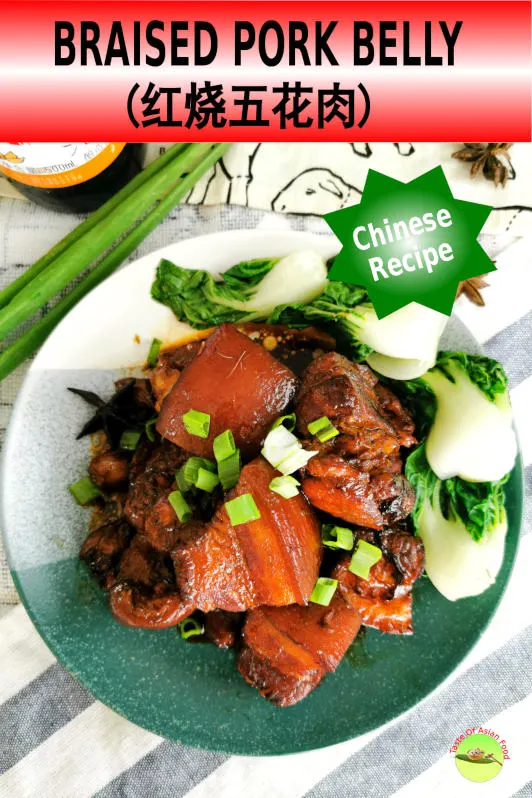
Note: This post may contain affiliate links. Please read my privacy policy for more info. I may receive commissions for purchases made through links in this post. As an Amazon Associate, I earn from qualifying purchases.
How to prepare the Chinese braised pork belly
There are three steps in this recipe. First, blanch the pork to remove the impurities, then pan-fry meat in the mixture of oil and sugar to caramelize the surface, and lastly simmer until soft and tender.
Here are the details on how to prepare the Chinese braised pork belly.
1. Use pork belly (not other cuts)
Pork belly is excellent for braising because it is tender and has the melt in the mouth texture after braising, resulting from the melting of fat interlaced between the lean meat.
The best size for the pork pieces is one-inch cubes. It takes much longer to cook until tender for pieces larger than this size. Since the meat will shrink after cooking, you can cut it slightly bigger than what you expect after braising.
2. Blanch the pork belly
- Bring a pot of water to boil.
- Cut half an inch of ginger into slices. You don’t need to peel the ginger skin because the purpose is to flavor the water, in which the ginger will be discarded.
- Also, cut a stalk of scallion into 1-inch sections. Put the ginger slices and scallion sections into the water.
- Blanch the pork belly pieces over medium heat for about 5 minutes. The ginger and scallion help to remove the unpleasant porky smell, and the blanching process removes the impurities and blood from the pork.
- After five minutes, remove the pork from the water and clean them under running water. Drain off the access water by placing them in a colander. After the excess water has dripped off, dry the pork pieces with a clean cloth or kitchen towel.
- Reserve some blanching water and pass it through a wire mesh strainer. We will use the blanching water to braise the pork later.
Now you can proceed to caramelize the pork in the pan in the following step.
3. Prepare the oil and sugar mixture to caramelize the pork
- Add a tablespoon of cooking oil and sugar into a nonstick pan. You may need slightly more oil if you use a regular pan.
- Heat the sugar and oil low and slow until all the sugar is dissolved. When the sugar turns to amber color, add the dried pork pieces into it.
- Make sure the pork pieces are dry or else the oil will splatter unduly.
- The sugar will caramelize quickly on the surface of the pork pieces. Flip over the pork so that all the sides are properly sear and colored. The whole process is quite fast, which will take only about two minutes.
This step is essential for red-cooked meat, as it adds the reddish hue to the meat as the result of caramelization.
4. The seasonings required for the braised pork
The seasonings required for this recipe are generally available in any typical Chinese kitchen pantry.
Soy sauce
Soy sauce is a critical ingredient for the braised pork. There are two types of soy sauce required. The first type is the dark soy sauce, which is thicker, less salty, and caramelized. The second type is the light soy sauce, which is saltier, thinner than the dark soy sauce, and lighter.
I am using equal portions of both soy sauces. The pork’s color will be too dark and tastes slightly bitter if you only used the dark soy sauce. On the contrary, the pork lacks the dark and thick caramelized glossy finishings if you use light soy sauce alone.
There is no need to use salt to braise the pork. You can add more light soy sauce to enhance the flavor and saltiness instead.
Ginger and scallion
Cut the ginger into thin slices and the scallion into one-inch sections. Both ingredients will release the flavor to the braising liquid and partially disintegrate after prolonged cooking.
Ginger and scallion are a perfect combination in a variety of meat dishes in Chinese cooking. If you like the taste of this combination, you should try the stir-fry beef with ginger and scallion on this blog.
Wine and star anise
Shaoxing wine is commonly used in Chinese cooking. You can use dry sherry as the substitute if it is not available.
Star anise is optional. But I always include it in the recipe because I like its aromatic flavor. You may also add cinnamon bark in addition to the star anise.
5. Simmer the pork until tender
Once you have everything in place, let’s start braising the pork.
- Transfer the pork pieces to a small pot.
- Used the reserved blanching liquid to deglaze the pan, and transfer the liquid into the pot.
- Add the soy sauce, ginger, scallion, wine, star anise, and more blanching liquid enough to submerge all the pork pieces. Bring it to boil over medium heat.
- Once it is boiling, reduce the heat to a bare simmer. Braise the pork with the lid on for 1 1/2 hours or until the meat is soft and tender.
- Check the amount of water occasionally. Add more water if necessary. Stir and turn over the pork pieces from time to time to ensure even cooking.
- After 1 1/2 hour, do a taste test and check the doneness of the meat, and adjust the saltiness.
- Turn the heat to medium and boil it uncovered until the braising liquid is reduced to a thick sauce. The sauce should be quite sticky and glaze the surface of the meat to form a glossy sheen.
- Dish out and garnish with thinly sliced scallion. Serve.
Chinese braised pork belly is best to serve with steamed rice or noodles. It is also an ideal combination to serve with vegetables such as bok choy.
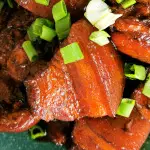
Braised pork belly (红烧肉/hong shao rou/red cooked pork)
Braised pork belly (红烧肉/hong shao rou/red cooked pork) is a well-known pork dishes prepared with a combination of ginger, garlic, and soy sauce and a myriad of aromatic spices over an extended period. The pork is cooked until the fat is gelatinized, and the meat attains the melt in the mouth texture.
Ingredients
To blanch to pork:
- 500g (1 pound) pork belly
- 1 stalk scallion
- 1cm (1/2 inch) length ginger
Others:
- 1.5 tbsp sugar
- 1 tbsp cooking oil
- 2 tbsps Shaoxing wine
- 1.5 tbsp light soy sauce
- 1 tbsp dark soy sauce
- 1 stalk scallion
- 1cm (1/2 inch) length ginger
- 1 star anise
- water to braise and blanch the pork
Instructions
Blanch
- Bring a pot of water to boil. Add the ginger, scallion, and blanch the pork belly pieces over medium heat for about 5 minutes.
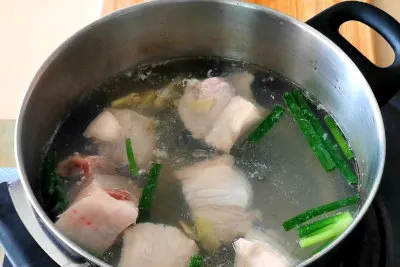
- After five minutes, clean the pork under running water and keep them dry with cloth or kitchen towel. Reserve some blanching water and pass it through a wire mesh strainer.
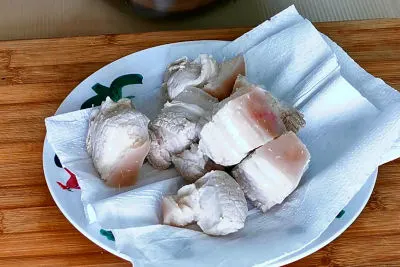
Pan-fry
- Heat the sugar and oil in a nonstick pan. When the sugar turns to amber color, add the dried pork pieces into it.
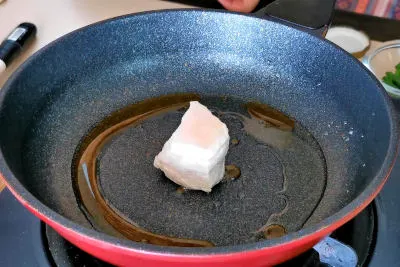
- Pan-fry the pork for two minutes until all the sides are sear and colored.
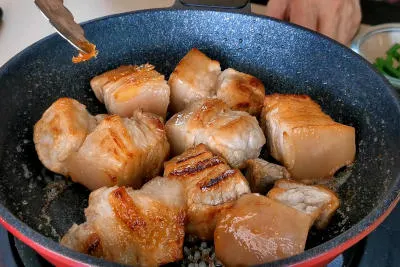
Braise
- Add the pork, soy sauce, ginger, scallion, wine, star anise, and blanching liquid enough to submerge all the pork pieces to a pot.
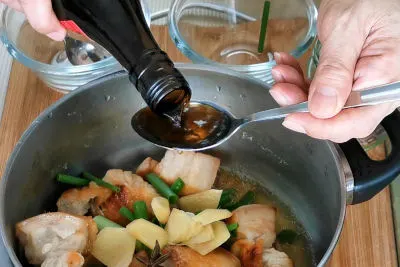
- Braise the pork over low heat with the lid on for 1 1/2 hours or until the meat is soft and tender. Turn the heat to medium and boil it uncovered until the braising liquid has reduced to a thick sauce.
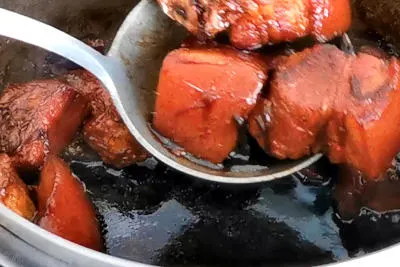
- Dish out and garnish with thinly sliced scallion. Serve.
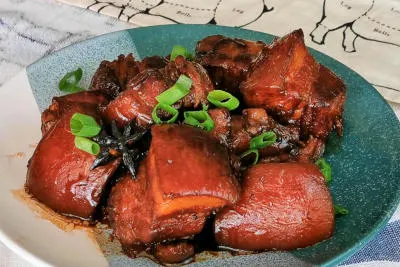
Recommended Products
As an Amazon Associate and member of other affiliate programs, I earn from qualifying purchases.
-
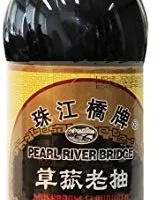 Pearl River Bridge Mushroom Flavored Superior Dark Soy Sauce, Plastic Bottles, 16.9 oz.
Pearl River Bridge Mushroom Flavored Superior Dark Soy Sauce, Plastic Bottles, 16.9 oz. -
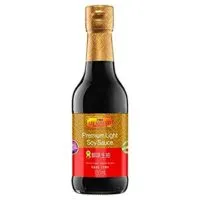 Lee Kum Kee Premium Light Soy Sauce - 150ml (5.27 fl oz)
Lee Kum Kee Premium Light Soy Sauce - 150ml (5.27 fl oz) -
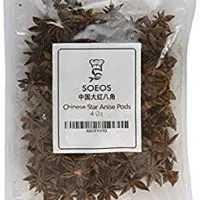 Soeos Star Anise Seeds (Anis Estrella), Whole Chinese Star Anise Pods, Dried Anise Star Spice, 4 oz.
Soeos Star Anise Seeds (Anis Estrella), Whole Chinese Star Anise Pods, Dried Anise Star Spice, 4 oz. -
 GreenLife CW002044-002 Healthy Nonstick Dishwasher Oven Safe Sta Soft Grip Diamond Reinforced 8" Ceramic Non-Stick Open Frypan, 8-Inch, Black
GreenLife CW002044-002 Healthy Nonstick Dishwasher Oven Safe Sta Soft Grip Diamond Reinforced 8" Ceramic Non-Stick Open Frypan, 8-Inch, Black
Nutrition Information:
Yield: 2 Serving Size: 1Amount Per Serving: Calories: 229Total Fat: 13gSaturated Fat: 3gTrans Fat: 0gUnsaturated Fat: 10gCholesterol: 37mgSodium: 1288mgCarbohydrates: 12gFiber: 1gSugar: 10gProtein: 13g
This data was provided and calculated by Nutritionix on 6/15/2020

Fried pork belly Hakka style - Quick and easy recipe (absolutely delicious)
Saturday 20th of July 2024
[…] Braised pork belly is a well-known dish prepared with ginger, garlic, soy sauce, and myriad aromatic spices. It is cooked over an extended period until the fat is gelatinized and the meat attains a melt-in-the-mouth texture. […]
Carol
Monday 1st of January 2024
This is good, though my braising sauce never reduced, which was disappointing. Not sure what happened. I did double the recipe but can't imagine that's what cause the liquid not to reduce.
KP Kwan
Tuesday 2nd of January 2024
An easy way to solve the problem is to remove the pork belly from the liquid after completing cooking. Then, increase the heat, boil the liquid until it reduces, and pour it back into the pork belly.
carol
Wednesday 27th of September 2023
into the middle of it, I totally had my doubts, but this is amazing!
Ruth
Wednesday 28th of June 2023
Tried this last night. So ono! (As we say here in Hawaii) My husband was impressed and is taking the leftovers for lunch. The ginger, anise and dark soy sauce really pump up the flavor.
KP Kwan
Sunday 2nd of July 2023
Great to know that you love it
Gary
Wednesday 1st of March 2023
Can you use an artificial sweetener instead of sugar for this recipe? Thank you in advance.
KP Kwan
Wednesday 1st of March 2023
You can use artificial sweeteners as a substitute, but the taste might differ slightly. Saccharin and aspartame are less heat stable, so I think they are not for prolonged cooking. It is best to consult a nutritionist for this aspect.